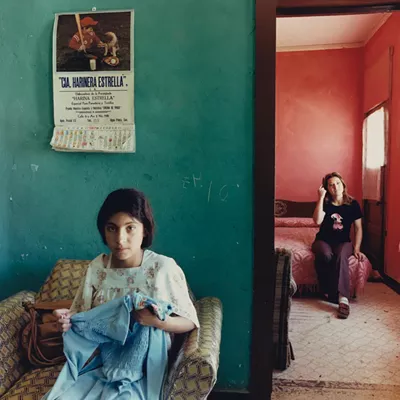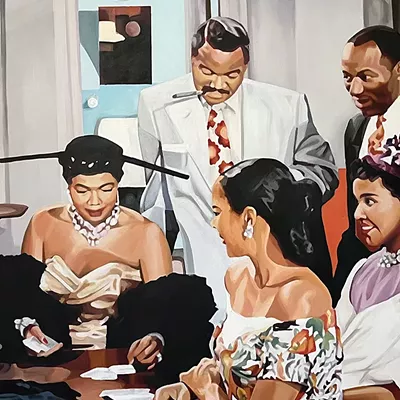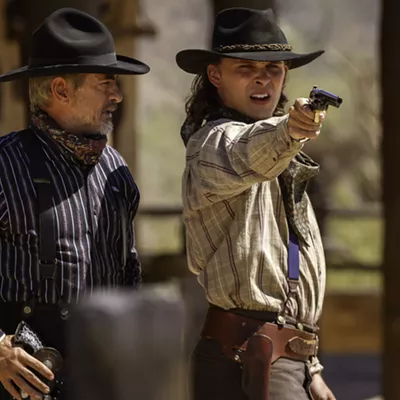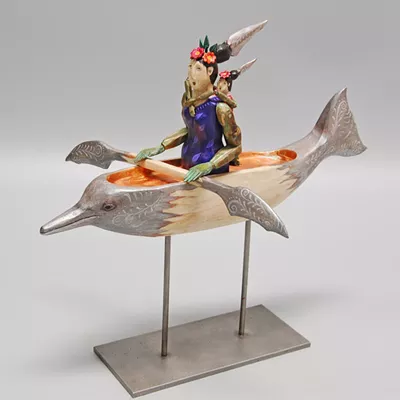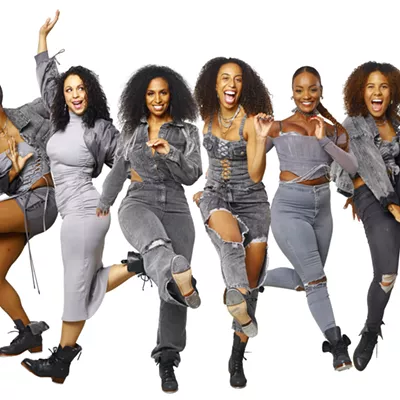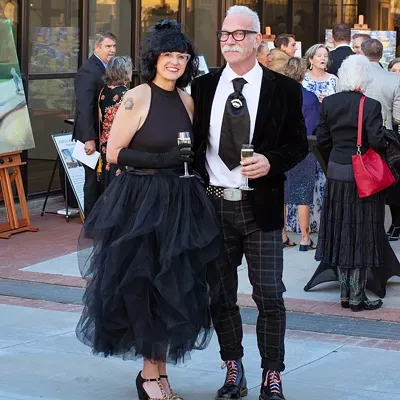In the year 2000, the waning days of Al Gore's doomed quest for the presidency, the man who would later joke that he used to be the next president of the United States gave a speech.
Gore was outdoors, standing on a makeshift platform painted with American flags. Darkening clouds hovered overhead, and a wind whipped around him, blowing his dark hair skyward. Dressed in white shirtsleeves and a tie, the candidate clutched a big black mike. Raising his right hand for emphasis, he shouted out his dreams for the nation.
Photojournalist David Burnett was in the crowd, covering the event for Newsweek. He got a dramatic shot of Gore looming overhead, but the magazine never ran it. Burnett's photo was black and white and the editors wanted color. But with its tempestuous sky and dark shadows, the moody photo captured a sense of impending disaster.
And after Gore's hopes for the presidency crashed and burned, the picture turned elegiac. The next year, Burnett's unpublished work won a prize in the White House News Photographers Association's Eyes of History contest. In the ensuing years, the picture, "Al Gore," now on view at Tucson's ArtsEye Gallery, has achieved cult-favorite status among photogs in the know.
It seems Burnett took the now-iconic photo with a plastic toy camera.
Well, some might dispute the characterization of "toy," but the Holga camera he used is undeniably made of plastic. Even now, 13 years after Gore's crusade, it retails for $29.99 and up, but not way up. It was developed in the early 1980s in China as a cheap film camera for the people of the People's Republic.
It was cheap, to be sure, but it was also flawed: light leaks marred the images, dark fields (called "vignettes"), so effective in the Gore shot, blurred the edges of the pictures. Weirdly dark pictures of the birthday child did not delight families. But what was a failure in the mass market became a success in the arty market.
Photographers loved the camera's quirkiness and unpredictability. It still uses the old-fashioned medium of film, and Burnett told an interviewer that after digital came in, all of his competitors were shooting crisp, clear, excellent—and depressingly similar—images. Breaking away from the pack with his weird, inexpensive plastic box, he delivered idiosyncratic photos.
Holga Inspire, a traveling exhibition at ArtsEye that displays 41 Holga prints by 10 different photographers, gives a fascinating introduction into what can be done on the cheap.
The photographers in the show are pros who've mastered the camera's oddities and who bring a discerning eye to the enterprise. Besides the Gore shot, Burnett is exhibiting three other great images. The White House that Gore never got to occupy is pictured as in a dream, sheltered beneath towering trees. In another pic, a skier flies horizontally off a mountain in the Salt Lake City Olympics. A Marine mechanic, caught in a beautifully composed shot, full of circles and diagonals, stands proudly by the jet that his labors keep in the air.
But the exhibition photographers show themselves adept at more than journalism. The show has in-your-face street photographs, arty experiments in multiple exposures, dreamy colored flowers and a Holga-abetted surrealism.
Seattle artist Michelle Bates, known as the Queen of Holga, is exhibiting four wonderfully loopy black and whites. "Helter Skelter," from 1991, is an ant's-eye view of a roller coaster from down in the grass; high above, the tracks dip and twist and careen. Tilting, vertical poles hold the whole contraption up.
Bates modifies her camera; in her four photos in this show she's masked the lens, blocking out the edges so that her images have the shape of a 1950s TV screen, framed by black. Looking at her pictures, you have the feeling of peering into the distant past, or dreams. In "Snowdude," 1992, a small, smiling snowman is positioned on the steps leading to an all-American front door. The snowman's smile is silly, but the picture feels melancholy, an archetype of everyone's childhood.
For all their dreaminess, Bates likes to inject a dose of realism into her photos by emphasizing the physical process that produced them. The numbers and letters printed on rolls of film become part of her final image. In "Shadow & Window, Boston," 2006, you can see the word "Kodak 400" above the murky shadows of branches.
A number of the Holga enthusiasts use the camera and its large-size film to create color photos whose hues are nothing like those of crisp digital. Pauline St. Denis' "Madame," 2001, a photo of what appears to be a French brothel, glows with a corporeal red—the color of blood and body parts. St. Denis has also experimented with multiple exposures. The provocatively bent legs and bare breasts of the prostitutes are repeated endlessly, so that the picture's two real-life women metamorphose into a terrifying sex trade battalion. Call the pic Toulouse Lautrec gone wild.
Susan Bowen's multiple exposures capture mostly calmer subjects, farm equipment in the American heartland, for instance. "Prairie City Grain Elevator" takes readily to Bowen's long, narrow horizontal format—the image is perhaps 5 inches high and 25 inches long, just like the sweep of agricultural land in the nation's center. The elevators are dusty blue and beige and brown and steel. Repeated over and over across her picture plane, they become an industrial geometry of spherical tanks and ladders and cones imposed upon the flatlands.
Other photogs use the camera for close-up portraiture: Tammy Cromer Campbell has nice pictures of mothers and children. Street photog Harvey Stein channels the late, great Garry Winogrand in bold black-and-white photos, cross-cut with the diagonals of the streets and the long shadows of city dwellers striding through the sunlight.
But Teru Kuyumama turns the conversation back to photojournalism, providing a wrenching demonstration of the eyewitness uses to which the cheap camera can be put. Pros working in rough conditions can get into trouble when they bring expensive equipment into the dusty trenches and sandy fields of war. With a passel of plastic cameras in their duffels, if one gets wrecked they can move on to another.
Kuyumama worked in Afghanistan, and his strong images argue that vision—and courage—are what make great war photographs, not the price of the lens. Out in a great flat desert on the Tajikstan border, he captured a belligerent-looking militiaman on horseback. In what appears to be a refugee camp, he photographed a mother and child under a sloping tent. And in a crumbling, bombed-out cityscape, Kuyumama took a picture of a lone woman. She's veiled from head to toe, but her eloquent body language screams out the terror of civilians suffering through never-ending war.

